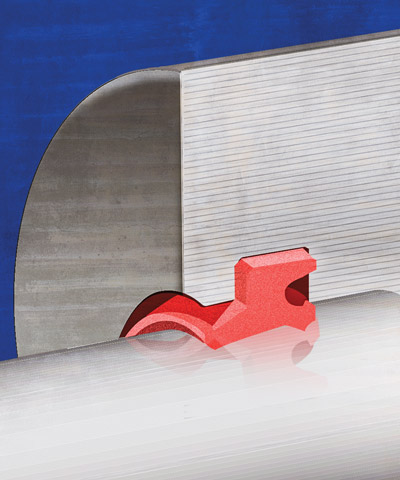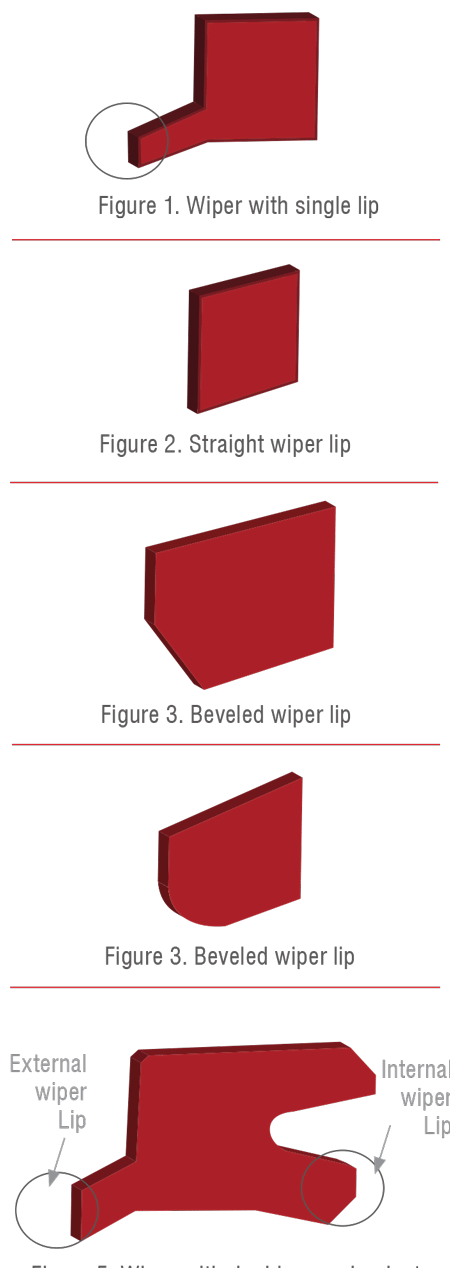How to Mitigate Contaminant Ingression in Hydraulic Systems
 Hydraulic wiper seals are the first line of defense in many hydraulic systems. Unfortunately, they are also a perpetual problem for most users of hydraulic machinery. Microscopic scratches and gouges on the surface of cylinder rods can significantly reduce the life of wiper seals and give contaminants an easy path into the system. Particles as small as 5 microns can act like sandpaper on these surfaces, causing a chain of wear that grows exponentially in these fine-tolerance systems.
Hydraulic wiper seals are the first line of defense in many hydraulic systems. Unfortunately, they are also a perpetual problem for most users of hydraulic machinery. Microscopic scratches and gouges on the surface of cylinder rods can significantly reduce the life of wiper seals and give contaminants an easy path into the system. Particles as small as 5 microns can act like sandpaper on these surfaces, causing a chain of wear that grows exponentially in these fine-tolerance systems.
Wiper seals, which are also known as scrapers, excluders or dust seals, are installed on the external side of the cylinder head to prevent dirt, dust, chips and moisture from entering the cylinder/piston rods as they retract into the system. This in turn prevents contamination of the hydraulic oil, which could damage wear rings, seals and other sensitive components.
Wiper Seal Designs
Wiper seals are not created equal, nor should they be, as they must work in many diverse industries. They must also deal with contamination from high-pressure washdowns, exposure to extreme weather and chemical attacks. To survive these conditions, wiper seals are typically made from heavy-duty materials like high-performance polyurethane. In addition, there is the design factor to consider, including the seal’s lip and groove geometry.
When the cylinder rod extends past the rod seal, a thin film of oil remains on the rod, trapped in microscopic surface imperfections. The thickness of the oil film will depend on the surface finish, rod seal and surface speed of the rod. During the return stroke, this thin film can be removed by an aggressive wiper lip, resulting in system leakage. Therefore, it is important to properly pair wiper and rod seals. For example, an aggressive wiper lip design requires an aggressive rod seal lip design. If the wiper and rod seals are not matched correctly, leakage and premature failure can occur.
Some of the more common wiper seal designs include single lip, straight lip, beveled lip, rounded lip and double or redundant lips. The single lip and straight wiper lip designs are the most aggressive. They offer the best scraping and dirt removal performance, and are recommended for applications with high contamination.
A beveled wiper lip or chamfered lip is less aggressive. The beveled lip allows the microscopically thin oil film on the rod to be retracted back into the system while providing adequate dirt exclusion in less contaminated environments.
The rounded lip is the least aggressive design and is typically used in pneumatic applications to maintain a thin oil or grease film on the rod and to keep the piston bearing and seal lubricated.
Double or redundant wiper lips are one of the most effective ways to improve a system’s sealing performance. This design must be paired with long-life rod seals. It eliminates the release of built-up fluid pressure between the wiper and rod seals by releasing pressure past the rod seal and into the system.
Hardware Surface Finishes
 The cylinder rod’s surface finish can severely impact the life of a wiper seal. A mating surface that has scratches, scores, nicks or spiral machining marks can create leak paths and be abrasive to the seal. As a rule, the lower the sealing surface finish, the better the overall seal performance. A lower finish value generally means reduced wear and increased seal life. However, too smooth of a finish will lead to a significant increase in seal wear. Without microscopic peaks and valleys, no lubrication can be retained between the seal lip and the sealing surface. These peaks and valleys are needed to channel lubricant and prevent direct contact that would cause friction and wear.
The cylinder rod’s surface finish can severely impact the life of a wiper seal. A mating surface that has scratches, scores, nicks or spiral machining marks can create leak paths and be abrasive to the seal. As a rule, the lower the sealing surface finish, the better the overall seal performance. A lower finish value generally means reduced wear and increased seal life. However, too smooth of a finish will lead to a significant increase in seal wear. Without microscopic peaks and valleys, no lubrication can be retained between the seal lip and the sealing surface. These peaks and valleys are needed to channel lubricant and prevent direct contact that would cause friction and wear.
For polytetrafluoroethylene (PTFE)/Teflon seals, the transfer of a thin film of PTFE from the seal lip to the mating dynamic surface is critical for improved seal life. Dynamic surfaces with relatively rough finishes wear the seal lip material too rapidly. However, extremely smooth dynamic surfaces result in a material transfer that is insufficient to form a thin film and will lead to an increase in seal wear. The parameters used to describe surface finish are defined in ISO 4287, as shown in the table below.
Bellows/Boots
Many factors must come together for wiper seals to work properly. A good contingency or backup plan for your wiper seals is to use bellows or boots. Bellows offer an effective way to keep contaminants out of your cylinder wiper seals and thus out of the hydraulic system. They exclude contaminants by shrouding the cylinder rod as it moves in and out between the wiper seal and rod seal. This action ensures the full length of the cylinder rod is covered and seals out contaminants like dirt, dust, water and process contaminants.
Bellows can be made of rubber, vulcanized canvas, Gor-Tex, injection-molded polyvinyl chloride (PVC) or fire-resistant fabric. While they are excellent at keeping out contaminants, they can also make it difficult to inspect the seals.
| Parameter | Definition (ISO 4287:1997) |
|---|---|
| Ra | The arithmetic mean of a surface finish profile within a sampling length |
| Rp | The largest peak height of a surface finish profile within a sampling length measured from the mean line |
| Rz | The average of the sums of the largest valley depth to the highest peak of a surface finish profile within a sampling length |
| Rmr (Tp) | The ratio of the material length at a specified depth for a surface finish profile |
Contamination Control
If you suspect your hydraulic system is becoming sluggish and leaking oil past the cylinders, remove a filter and dissect it. Empty the contents onto a white towel and look at it under a microscope. If you have an oil analysis program, check the test results to see if there has been an increase in wear debris and elastomer contamination. If so, a seal may be going bad and the cylinder may be starting to wear.
Before having the culprits repaired, filter the hydraulic oil using an offline filtration system that includes 5-micron filters with a beta ratio of 75-200. While an online filtration system may also work, it would be wise to change the filters before starting. They may already be clogged and just circulating contaminants through the system.
After you have cleaned up the oil and replaced the worn components, consider the cost to change the components as well as the downtime and man-hours involved. If this has happened before, add that to the tally. I’m sure you now have enough justification to outfit your system with bellows, desiccant breathers, quick connects, proper sample ports and sight glass modifications to fully enclose the system and gain the reliability you’ve only dreamed about.
As with all machinery, hydraulic systems must be inspected periodically. Daily or weekly inspections of your systems and components can save thousands of dollars in repairs and downtime. Remember, it costs much less to do it right the first time than to have to fix it afterward. Also, if you don’t fix it correctly, the cycle of ingression into the machine will start all over again once you push the start button.
